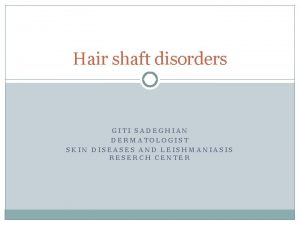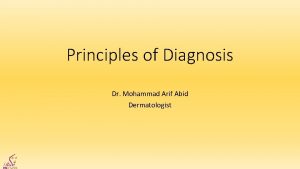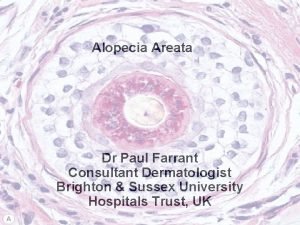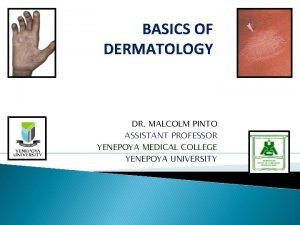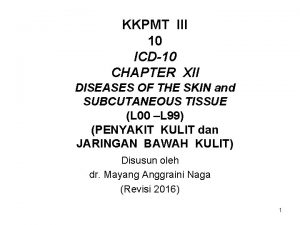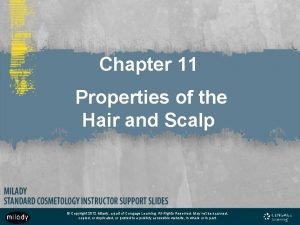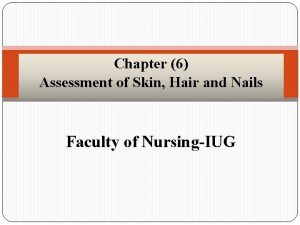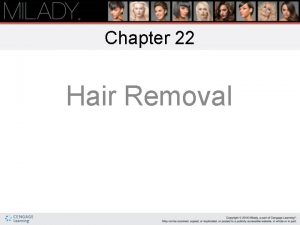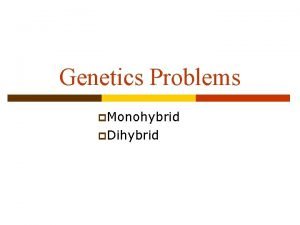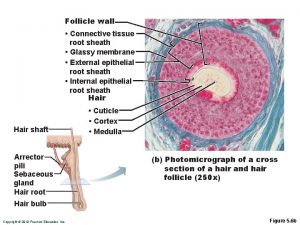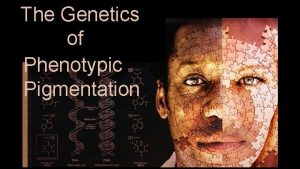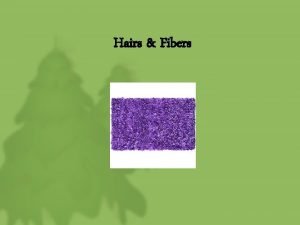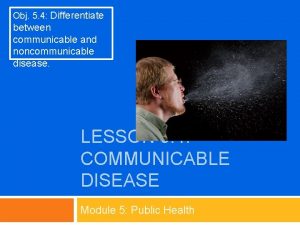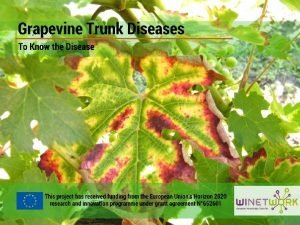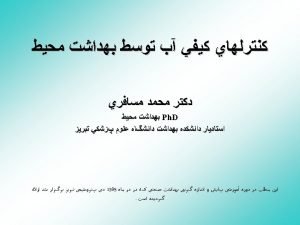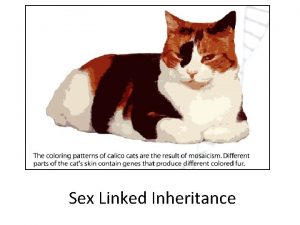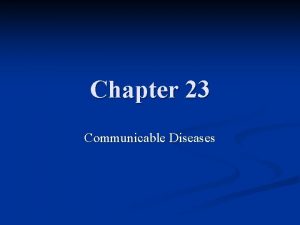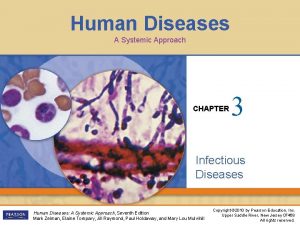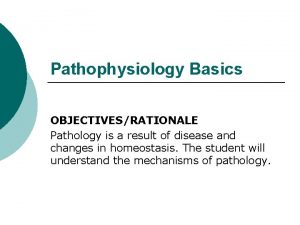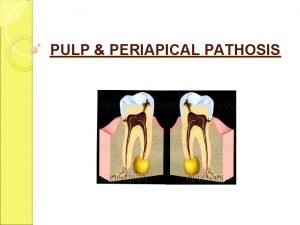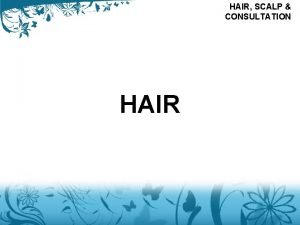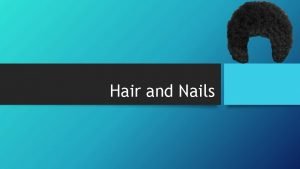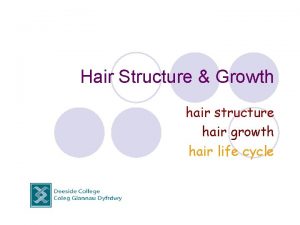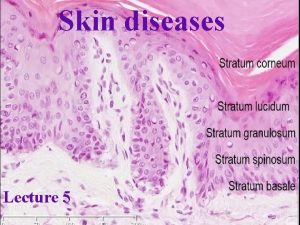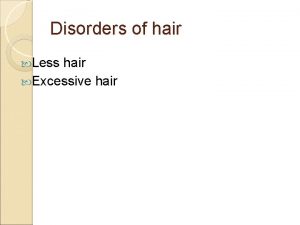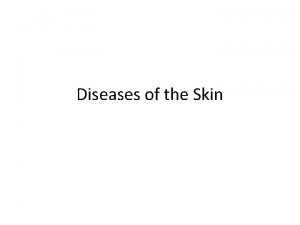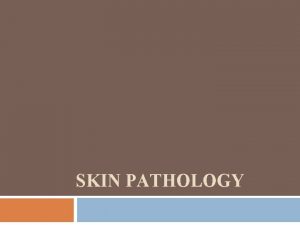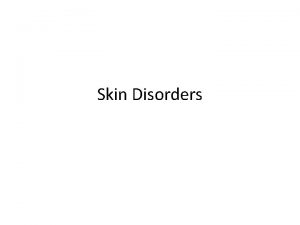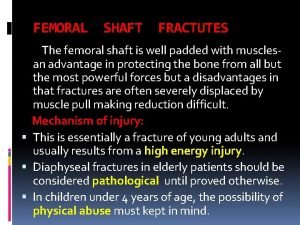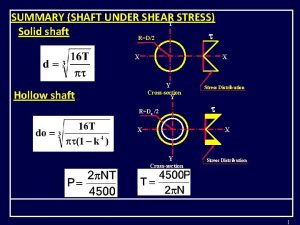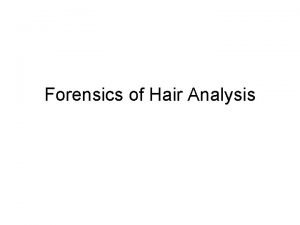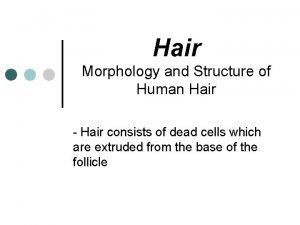Hair shaft disorders GITI SADEGHIAN DERMATOLOGIST SKIN DISEASES












































































- Slides: 76

Hair shaft disorders GITI SADEGHIAN DERMATOLOGIST SKIN DISEASES AND LEISHMANIASIS RESERCH CENTER


Medulla. Cortex, Cuticle

• The hair follicle is the structure of skin from which the hair shaft emerges. • The hair shaft grows from germinative cells in the hair bulb deep within the dermis. • The follicle is lined by inner and outer sheaths, which protect and shape the growing hair. • A muscle called the erector pili attaches to the outer root sheath below the sebaceous gland. When the erector pili muscle contracts, e. g. when cold, the hair shaft stands up (goose bumps).

• The medulla and cortex have pigment cells responsible for hair colour. • The cuticle is the outer and strongest part of the hair shaft. It is made up of dead flattened cells that overlap each other. • The cuticle is keratinised i. e. , the cells are largely made of a protein called keratin; keratin is also an important component of skin and nails. • The sebaceous gland produces sebum, which protects the hair shaft and acts as a natural conditioner.



• Hair grows in cycles so the structure of an individual • • hair apparatus varies. Anagen – growing phase (4 to 7 years for scalp hair) Catagen – in between phase (a few weeks) Telogen – resting phase (a few months) Then the new anagen hair shaft starts to germinate within the same follicle, and it pushes out the telogen hair resulting in normal hair shedding or moulting.


Normal hair variations 1) Straight 2) Wavy 3) Curly ( helical ) 4) Woolly or peppercorn ( spiral )

Variations among races wide structural variability even in normal hair – Asiatic hair : visually straight – Caucasian hair : may be straight , wavy or curly. – Negroid hair : woolly or peppercorn.

Hair shaft Defects A. Inherited eg. Trichorrhexis invaginata B. Acquired eg. Trichoptilosis

What is a hair shaft defect? • A hair shaft defect is any structural abnormality of the hair • • shaft. Some hair shaft defects are easily diagnosed with the naked eye, others may require microscopic examination. Hair shaft defects may result in: No visible hair abnormality Hair loss (alopecia) Coarse or frizzy hair Uncombable hair – when disordered hair bundles grow in all directions and cannot be arranged by combing Fragile hair – hair shafts with reduced tensile strength. A gentle pull of several hair shafts will help determine if the hair is abnormally fragile.

What causes hair shaft defects? • Hair shaft defects may be due to external injury or • • • genetic abnormality. External injury to hair shaft. Repeated physical injury is the commonest cause of increased hair fragility. This may be due to: Excessive grooming Traction from braiding or tight pony tail Heat from a hair dryer Chemical injury may be caused by: Perming lotions Straighteners Dyes

Weathering ●Sun ●Wind ●Swimming ●Washing ●Friction ●Excessive hair styling







Heat is a great enemy to hair. (the dryer must always be used with great care and at a moderate setting )

Trichoclasis refers to the common “greenstick” fracture of the hair shaft, consisting of a transverse fracture splinted by an intact cuticle. There is no constant abnormality of the cuticle or cortex in this condition. Trichoclasis can be found : 1)in different hair shaft abnormalities 2) simply following excessive hair care and trauma. Usually when physical trauma accounts for trichoclasis, the affected area shows sporadic and patchy damage, which can be reversed with gentle hair care.

Trichoptilosis - split ends in the hair ( Trichoptilosis) common for dry hair. -occur when the protective layer of the hair, or cuticle, becomes damaged. - It is usually caused by frequent washing, excessive dying, vigorous brushing, overuse of chemicals. KETOCONAZOL SHAMPOO



- these weaken the hair, strip away the cuticle, and make the middle layer, or cortex, unprotected, and, consequently, lead to split ends and hair breakage. Unfortunately, it is impossible to mend broken hair. The only way to get rid of split ends is to cut them off

How to Prevent Split Ends 1) not wash the hair with shampoo more than 2 -3 times a week, as shampoo dries your hair out. 2)Do not brush wet hair. (Hair is more vulnerable to splitting when it is wet). 3)Instead of a round brush, use a flat paddle brush with wide tooth for everyday styling. 4)apply a leave-in conditioner for dry hair.


Prophylaxis of acquired hair shaft Defects ●Minimize damage from hair cosmetics ●Avoid harsh shampoos to comb dry hair ( since friction is higher in wet hairs )

Hair dryers applied on wet hair at high temperatures may also provoke the well – known phenomenon of Bubble hair.

Bubble hair • Bubble hair is characterised by hair shafts with large “bubbles” within them. These thin the hair cortex and break the hair shaft. There may be a genetic predisposition to bubble hair. However presentation is often precipitated by external injury such as use of a hair dryer, physical or chemical hair straightening or curling irons. – treatment: trimming the affected hair


Genetic hair shaft abnormalities Increased fragility No increased hair fragility Bubble hair • Acquired progressive Beaded hair / • monilethrix Pili torti Bamboo hair / trichorrhexis invaginata Trichorrhexis nodosa Trichothiodystrophy • • • kinking of hair Loose anagen hair syndrome Ringed hair / pili annulati Pili bifurcati Spun glass hair / pili trianguli et canaliculi Woolly hair Tufted hair / pili multigemini

Beaded hair / monilethrix • The name beaded hair reflects hair shafts with narrowed segments between “nodes” of normal thickness. • It is also called monilethrix. The scalp is most commonly involved. • The affected hair shafts appear beaded a few months after birth. They break off leaving patches of scalp with abnormally short hairs. The scalp may also have a rough appearance because of a build up of keratin around the hair follicle. • There is no known treatment.

• Monilethrix is inherited as an autosomal dominant characteristic. This means an affected individual has a 50% chance of passing it on to each of their male and female children. • It is caused by changes in the keratin gene cluster at chromosome 12.


Pili torti • Pili torti describes a flattened hair shaft with clusters of narrow twists at irregular intervals. The hairs are abnormally fragile. • It may be genetic in origin (inherited) or acquired. • When inherited, pili torti may be present at birth or appear during infancy. • Pili torti is associated with a number of inherited syndromes.


Pili torti

• Acquired pili torti may arise in the following circumstances: • Associated with anorexia nervosa and malnutrition • Following oral retinoid treatment (isotretinoin, acitretin) • At the edge of inflammatory scalp conditions such as cutaneous lupus erythematosus and lichen planopilaris, due to fibrosis (scarring), which distorts the hair follicle.

No treatment but it may improved during puberty The acquired form is after anorexia nevrosa and oral retinoid therapy

Bamboo hair / trichorrhexis invaginata • Bamboo hair or trichorrhexis invaginata is due to abnormal keratinisation. • The hair shaft cortex is structurally weak at specific points along its length. Harder adjacent segments of the hair shaft impact into these softer portions creating a ball and socket appearance. • The hair shaft may break with minimal trauma. • Trichorrhexis invaginata is a classical feature of Netherton syndrome


• Other ectodermal abnormalities, including keratosis pilaris, nail disease and teeth abnormalities. • Bjornstad syndrome, with sensorineural hearing loss (OMIM ID# 262000). • Bazex syndrome or follicular atrophoderma and basal cell carcinomas (OMIM ID%301845) • Menke disease, an X-linked condition of copper deficiency caused by an abnormal copper transporting ATPase, that results in mental retardation, motor deficiency, growth failure and skin hypopigmentation (OMIM ID#309400). The hair is thin, whitish and likened to “steel wool”.

Trichorrhexis nodosa • Trichorrhexis nodosa is the most common abnormality of • • hair structure. When a weak hair shaft partially fractures and the cortical cells fragment, uneven spurs form at the fracture point. Trichorrhexis nodosa may be congenital and occurs in children with mental retardation and argininosuccinic aciduria. Trichorrhexis nodosa may also be acquired, due to 1)hair straightening, 2)overheating by a hair dryer, 3)frequent swimming in chlorinated water, 4) excessive traction with tight braids and other forms of hair trauma.

Trichorrehexis nodosa Commonest form of hair shaft abnormality The hair is bracken like two brushes merging to each other Three types: 1)proximal: in patients after years of uncomplicated straightening of hair 2)distal: acquired progressive cuticular damage 3)circumscribed in scalp , mustache or beard

• The type 1 is almost always in black patients • Type 2 is always in blond hair and asians associated with trichoptilosis, or longitudinal split ends known as split ends • In type 3 which pruritus is a prominent symptom; scratching and rubbing may be the cause. • Among such diseases are circumscribed neurodermatitis, contact dermatitis, and atopic dermatitis. .



The curly hair that may result from isotretinoin therapy has been attributed to extensive trichorrhexis nodosa. Treatment is directed toward the avoidance of trauma to the hair.

Trichoscopy in trichotiodystrophy patients was non-specific. At a higher magnification hairs showed a non-homogenous structure reassembling grains of sand within the hair shaft and a slightly wavy contour

Acquired progressive kinking of hair • Acquired progressive kinking of hair is also called pubeshaarnaevus because it resembles pubic hair. In this rare disorder, scalp hair becomes progressively curly, frizzy, dry and difficult to comb. • It usually affects the vertex or frontotemporal area of young men and may progress to male pattern balding (androgenetic alopecia). • Acquired progressive kinking of hair may also be a side effect of retinoid therapy.

Loose anagen hair syndrome • Loose anagen syndrome is due to defective keratinisation • • of the inner root sheath, rather than the hair shaft itself. The loose hair shaft can be easily pulled out of the follicle, leaving localised or diffuse bald areas of the scalp. On light microscopy the abnormal hairs are seen to be in the anagen phase and often appear twisted with longitudinal grooves and ruffled cuticles. Loose anagen (hair) syndrome results in short, brittle hair. Although both sexes may be affected, it most often presents in young girls over the age of 2 years. They usually have blond or red coloured hair.

It may be diagnosed by the painless extraction of at least 10 hairs on a hair pull test of which over 80% of the hairs are in the anagen phase. It is inherited as an autosomal dominant condition with variable penetrance. Unfortunately there is no known treatment.

Pili bifurcati describes abnormal branching of the hair shaft. This can occur at multiple points. The branches often fuse together again further up the shaft. Each branch has its own cuticle.

Ringed hair / pili annulati showed a random pattern of intermittent abnormal cavities. Light bands observed by clinical examination appeared as dark bands when imaged by light microscopy, reflecting cortical spacers containing air in the light bands and fluid in the dark bands.


Spun glass hair / pili trianguli et canaliculi • Spun glass hair is also called pili trianguli et canaliculi, uncombable hair syndrome and cheveux incoiffables. The hair shafts have an irregular, triangular shape on cross section and an abnormal longitudinal groove running along the shaft. • Spun glass hair is due to abnormal keratinisation of the inner root sheath. This forms an inflexible tube through which the hair shaft must pass, distorting its shape and rendering it stiff and brittle. Light reflected from the flattened surface gives the hair a “spun glass” appearance.

Spun glass hair is associated with atopy (eczema), alopecia areata and ichthyosis vulgaris. There is no known treatment for spun glass hair. However, the condition may improve with age.


Woolly hair • Woolly hair describes unusually frizzy, tightly coiled hair. The hair shafts have elliptical cross sections, axial twisting and scattered areas of splaying. • It may affect the entire scalp or just a small area when it is considered a type of birthmark (naevus), the woolly hair naevus. • Woolly hair may be an inherited as an isolated condition (OMIM ID #194300) or present as part of a syndrome.


Tufted hair / pili multigemini • Tufted hair or pili multigemini describes multiple hair shafts bunched together and emerging from one follicle (like a toothbrush or doll's hair). Light microscopy confirms that all the hairs are surrounded by a single outer root sheath. The hair shafts are normal. • Tufted hair is a feature of scarring inflammatory scalp conditions, particularly the severe forms of scalp folliculitis known as folliculitis decalvans and dissecting cellulitis.



Treatment of hair shaft defects At present there is no specific treatment for inherited structural hair disorders. Occasionally there is spontaneous improvement as the child ages. In acquired structural hair disorders, stopping exposure to the causative agent may lead to improvement.

• Avoid excessive grooming and traction, braiding, hair • • • weaving, heat treatments, straightening, perming and dyes. Reduce exposure to sunlight – wear a hat. Wash hair with gentle shampoo, diluted in warm water. Apply a conditioner to freshly washed hair. Do not use a hair dryer, or use it with a cool setting. Discontinue isotretinoin and acitretin, unless essential. Gentle hair care is recommended. Short hairstyles are advisable. In some cases, a wig or hairpiece may be the most practical approach.

Hair color Melanocytes producing hair pigment are associated with the hair matrix, and melanogenesis occurs only during anagen. This cyclic melanin synthesis distinguishes follicular melanogenesis from the continuous melanogenesis of the epidermis.

With age, cyclic melanocytic activity in the follicular unit declines. By 40 years of age most individuals show evidence of graying. Graying mechanism: tyrosinase activity within hair bulb, defective migration of melanocyte from defective hair melanocyte reservoir in ors, damage of reactive oxygen specis to DNA of melanocytes

canities

Typically, white people start going gray in their mid-30 s, Asians in their late 30 s, and African. Americans in their mid-40 s. Half of all people have a significant amount of gray hair by the time they turn 50.

Graying of the scalp hair is genetically determined and may start at any age. begins at the temples then beard and the body hair is the last Premature whitening of scalp hair is usually caused by vitiligo, sometimes without recognized, or actually without, lesions of glabrous skin. Early graying (before age 20 in white or before age 30 in black persons) is usually familial;

Blond hair may become green in the swimming pool or may stain brown near the tar or crysarobin Alternating red and brown color or whitening of hair is seen in iron deficiency anemia it responds completely to iron suppliments Whitening of hair is seen in B 12 deficiency and IFN therapy and with chloroquin therapy

Selenium sulfide shampoo make the hairs yellow discoloration HIV elongated eyelashes and eyebrow and strengtening of the curled hair

Thank you for your attention
 Milady chapter 8 skin disorders and diseases
Milady chapter 8 skin disorders and diseases Chapter 8 skin disorders and diseases review questions
Chapter 8 skin disorders and diseases review questions Seborrheic keratoses
Seborrheic keratoses Acquired progressive kinking
Acquired progressive kinking Chapter 21 mental health diseases and disorders
Chapter 21 mental health diseases and disorders In what situation should nail service not be performed
In what situation should nail service not be performed Chapter 17 reproductive system diseases and disorders
Chapter 17 reproductive system diseases and disorders Chapter 8 cardiovascular system
Chapter 8 cardiovascular system Chapter 15 nervous system diseases and disorders
Chapter 15 nervous system diseases and disorders 10 diseases of lymphatic system
10 diseases of lymphatic system Chapter 6 musculoskeletal system diseases and disorders
Chapter 6 musculoskeletal system diseases and disorders Nail diseases and disorders milady
Nail diseases and disorders milady Dr swastika
Dr swastika Somc dermatologist
Somc dermatologist Dr donna braham contact number
Dr donna braham contact number Dermatologist
Dermatologist A dermatologist and an oncologist both provide
A dermatologist and an oncologist both provide Dr paul farrant
Dr paul farrant Malcolm pinto
Malcolm pinto Kode icd 10 telogen effluvium
Kode icd 10 telogen effluvium Bisul icd 10
Bisul icd 10 All mammals have hair. its main purpose is to
All mammals have hair. its main purpose is to Ringed hair milady
Ringed hair milady Thin skin vs thick skin
Thin skin vs thick skin Milady basic facial steps
Milady basic facial steps Stratum lucidum
Stratum lucidum Skin hair and nails system
Skin hair and nails system Skin hair and nails assessment
Skin hair and nails assessment Milady chapter 22 review questions
Milady chapter 22 review questions Hh
Hh The rebel will sit quietly when *
The rebel will sit quietly when * Hair histology
Hair histology Dark hair and blonde hair parents
Dark hair and blonde hair parents Hair grows in diagonal tubes called hair
Hair grows in diagonal tubes called hair Ringed hair
Ringed hair Medulla pearl shape
Medulla pearl shape Fixed hair method and movable hair method
Fixed hair method and movable hair method Chapter 24 sexually transmitted diseases and hiv/aids
Chapter 24 sexually transmitted diseases and hiv/aids Difference between communicable and noncommunicable
Difference between communicable and noncommunicable Immunocompromised diseases list
Immunocompromised diseases list Venn diagram of communicable and non-communicable diseases
Venn diagram of communicable and non-communicable diseases Modern lifestyle and hypokinetic diseases
Modern lifestyle and hypokinetic diseases Similar pictures
Similar pictures Non common communicable diseases
Non common communicable diseases Sexually transmitted diseases
Sexually transmitted diseases Waterwashed diseases
Waterwashed diseases Secondary immunodeficiency diseases
Secondary immunodeficiency diseases X linked diseases
X linked diseases Tronsmo plant pathology and plant diseases download
Tronsmo plant pathology and plant diseases download Cyst granuloma abscess
Cyst granuloma abscess Diseases in civil war
Diseases in civil war American quality gurus
American quality gurus Examples of communicable diseases
Examples of communicable diseases Nutritional diseases
Nutritional diseases Non communicable diseases
Non communicable diseases Mastigophora diseases
Mastigophora diseases Vitamins functions
Vitamins functions Chapter 23 lesson 1 understanding communicable diseases
Chapter 23 lesson 1 understanding communicable diseases Human diseases a systemic approach
Human diseases a systemic approach Purulent diseases of lungs and pleura
Purulent diseases of lungs and pleura Major nutritional deficiency diseases in emergencies
Major nutritional deficiency diseases in emergencies Diseases of the musculoskeletal system
Diseases of the musculoskeletal system Diseases caused by dust
Diseases caused by dust What causes genetic diseases
What causes genetic diseases Chapter 23 lesson 1 understanding communicable diseases
Chapter 23 lesson 1 understanding communicable diseases Types of pathogens
Types of pathogens Ascaris lumbricoides
Ascaris lumbricoides Albugo eye
Albugo eye Vitamin deficiency diseases chart
Vitamin deficiency diseases chart Section 19-3 diseases caused by bacteria and viruses
Section 19-3 diseases caused by bacteria and viruses Non communicable diseases infographic
Non communicable diseases infographic Protein deficiency diseases
Protein deficiency diseases Pulpitis classification
Pulpitis classification Periradicular diseases
Periradicular diseases Diseases spread by columbian exchange
Diseases spread by columbian exchange Myth and fallacies about non-communicable diseases
Myth and fallacies about non-communicable diseases Chapter 22 genetics and genetically linked diseases
Chapter 22 genetics and genetically linked diseases



